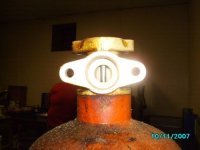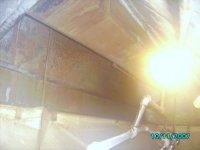There is some inaccurate information on this theard. I will try to clarify the information posted to date.
UL300 Fire Test Standard was first introduced in 1991, in response to fires in resturant appliances. Befroe the 1991 date, UL changed the effective date of UL 300 to November of 1994. Changes in cooking oil and fryers resulted in fire suppression systems not controlling fires. The cooking medium was changing from lard and other animal based oil to vegatable based oil. The fryers had more insulation added, which meant the oil stayed hot longer and kept boiling. this was important because the dry chemical saponifies (turns to a soapy substance) when it comes in contact with the oil. because the oil kept moving, the blanket of foam was disturbed and allowed the oil to reignite. Veggie oil spontaneously ignites at different temperaturs than animal oils. And the ignition point lowers as the oil ages. the combination of the insulation, and the change in oil rendered the older dry chemical suppression systems ineffective. Some of the older wet chemical systems were not effective on the newer fryers and newer oils also. UL developed a new standard, based upon fire tests done on real appliances. Prior testing was not done with appliances, but with mockups of applainces. Some of the previous testing was not real world, and some of the testing to UL 300 is not real world. As an example, the test for a grill is a square made of either 3/4 or 1" stock, I do not remember which. The square is filled with oil and allowed to ignite, and then burn for a length of time. None of my clients have squares welded on their grilles, and if I tried to put 3/4 or 1" of oil on the grille,it would run off on the floor. The fryer test is more realistic in that the grease is ignited and allowed to burn. The gas valve is not shut off, but continues to feed the fire. In real life,the gas valve is suppossed to shut the fuel off, but that may not happen. I do not remember the tests for other appliances. After a certain time, the fire suppression system is manually tripped. The suppression system is to control the fire. If the system does not control the fire, the engineers go back to work. The UL test for duct work is to slather grease in the duct, I do not remember the thickness,but it is more than I have seen even in chinese resturants. The grease is ignited and allowed a pre-burn, then the suppression system is manually tripped. If the UL inspector thinks the grease melted and ran out of the duct, he may not count that test as an accurate test. I have been told by the engineers at one company that the duct may turn colors, going past red orange to blue and even to almost translucent. The ducts are not made of 18 or 20 gauge, but much heavier metal. The tests are done many times. The testing is not done in the factory,but a building away from the main plant because of the exposure hazard. If the test fails, the the process starts over. If a manufacturer changes a part, even something as simple as a pull station, that part goes through the entire UL test cycle again. the minimum charge for a UL test is $80,000, & usually costs much more. UL 300 is for appliance coverage only. Duct and plenum coverage has stayed the same. No one makes a dry chemical that meets UL 300, but UL 300 does not ban dry chemical. UL would test a dry chemical system if asked, and paid to do so. The manufactures did not test current dry chemical systems as they knew the dry chemical would not pass UL 300. For a while, Ansul allowed dry chemical in the duct and plenum and wet chemical for appliance protection. To meet UL 300, some of the appliance nozzles needed to be redesigned, and the amount of the chemical increased. Where we used to protect a 48 inch grill with a single nozzle, now we use 2 nozzles or a nozzle with increased flow capabilities. this effectivly increased the amount of chemical required, usually twice as much chemical. Nozzles orientation has also been changed, as have nozzles heights.
Mr. Przat claims to have seen a change from dry chemical to wet and back to dry chemical. The first suppression system I know off was Safety First, who at first protected applainces only, and are now out of business. The next company was Range Guard, who have never used any chemical except wet chemical for resturants. Ansul used dry chemical, coming out w/wet later. For a time, Ansul had both chemicals avalable. General Fire Extinguisher used dry only, they have been out of business for several years. At one time, we could choose between wet and dry, as both met the codes in effect at that time.
For a time, water sprinklers were used to protect commercial cooking appliances, and the duct and plenum. Those sprinkler heads were high temperature heads. We still see some sprinkler heads protecting cooking appliances. Grinnel had the model EA-1 sprinkler head, which protected fryers. Grinnell voluntarily removed the listing of that head after UL 300 was introduced. Spriklers heads protecting cooking appliances had to be changed each year unless they were the glass bulb heads. I never saw that enforced. I did see one hospital cooking line protected by an Ansul over the appliances, along with sprinkler heads. The plenum was protected by a water wash and sprinkler heads.
We still see a number of dry chemical systems in use, as well as pre-UL 300 wet systems. I am upgrading an Ansul system next month, that despite claims by a competor, does not meet UL 300. Yesterday, we replaced a Pyro Chem that though installed as per codes in effect at the time, of installtion, no longer meets UL 300. As more information is gathered from fire, the codes will continue to evolve and change.
Ed, if you do not think the codes should change, you can become a member of NFPA and have a voice in the code process. NFPA is the only model code agency that has members of different interests. Or you could work with an ICC member to effect changes that you think are important. ICC only allows building officials to join their organization. ICC thinks your opinion and knowledge means nothing, while NFPA membership is open to all who have an interest in life/safey issues. As a member of NFPA, I can make suggestions as to changes in standards. I am also a member of National Fire Sprinkler Association, National Association of Fire Equipment Distributors, Oregon Fire Equipment Dealers (founding board member, past president & past secretary)& the Grease Police. Org (currently VP). These memberships give me credibililty and access to information that may not be redily available to everyone.
My statements may upset some people, if so, gather your information and contact me. I can be contacted at
fireman@eoni.com or PM me here or on GP. I am an opionated, old grouchy SOB, so I may or may not respond, depending on my attitude at the time.
A passing note about GP. I have seen some inaccurate information about GP. Some here have been on GP and then chosen not be part of the BBS. Some have been removed from the BBS. Membership is mainly,but not exclusivly exhaust cleaners. Grease Police is open only to those interested in doing a good job. Hacks are not welcome and will not be tolerated. We expect members to ask questions, offer information and interact with other members. If you cannot or will not accept those simple requirements, don't bother us. If you are interested in quality work, not too thin-skinned and can take some suggestions, you are invited for a visit. If we offend you, go some place else.
Thank you Mr. President for asking my opinion, and thank you Ron, for allowing me to post on your board.
Douglas Hicks
General Fire Equipment Co of Eastern Oregon, Inc





